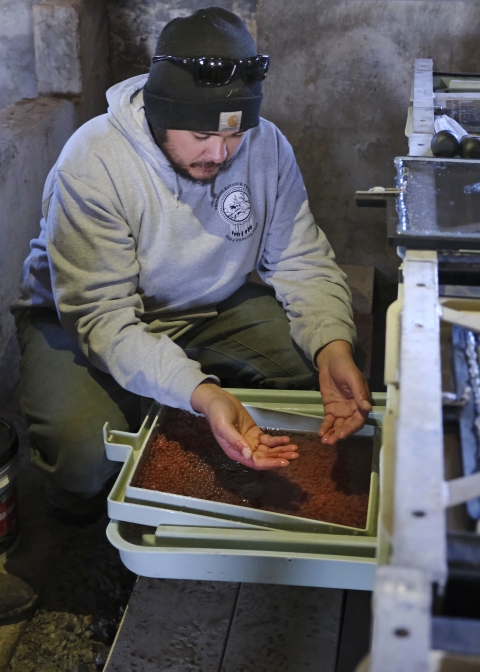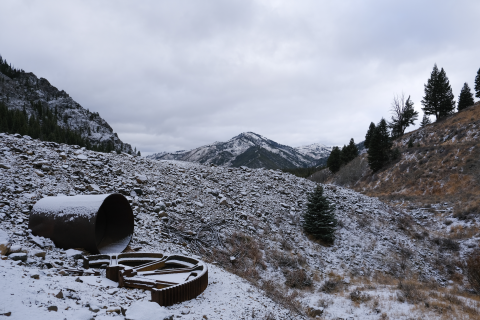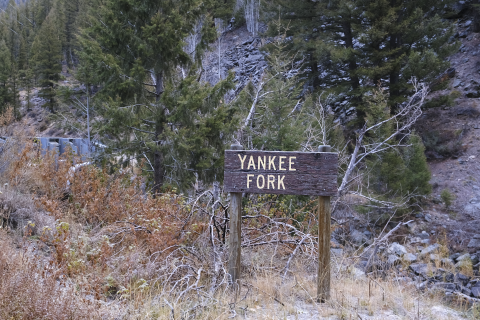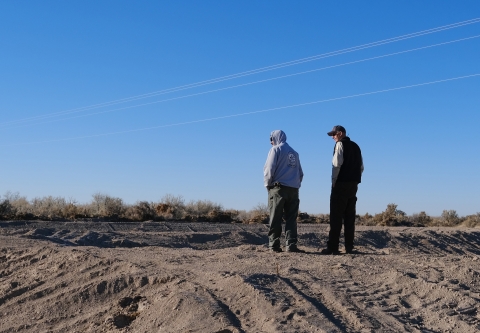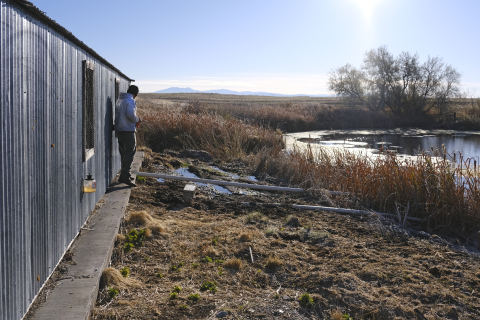On October 21, 2024, Aaron Colter took a nearly 300-mile round trip drive across central and southeastern Idaho to pick up an unusual and precious cargo – 50,000 Chinook salmon eggs.
Colter is the Hatchery Production Manager and Aquaculturist for the Shoshone-Bannock Tribe’s Fish & Wildlife Department. He transported the eggs from Idaho Fish and Game Assistant Hatchery Manager Sylvia Hamilton at Sawtooth Fish Hatchery on the Salmon River to the Tribes’ recently renovated Crystal Springs Fish Hatchery facility near Fort Hall, Idaho. For Colter, this was a familiar drive that he had taken many times, but on this day, he took his turns a little slower and had a few more nerves, knowing those small but mighty eggs were relying on him for a safe journey, and that the transfer was the culmination of decades of effort.
Yet, the transfer was also just the beginning. The 50,000 eggs will initiate a Chinook trial to rear Chinook salmon at Crystal Springs, ultimately to be released into the Yankee Fork of the upper Salmon River.
Why Here and Why Now?
For the Shoshone-Bannock Tribes Fish & Wildlife Department, having salmon eggs in hand along with a place to raise them is a significant milestone, decades in the making.
The Crystal Springs Fish Hatchery was purchased by Bonneville Power Administration for the Shoshone-Bannock Tribes nearly 30 years ago. In 2008, the Tribes entered into a fish accord with Bonneville Power and other federal agencies that addressed the government’s responsibilities to the Tribes to mitigate for the effects of dams on fish and wildlife. Operation of the Crystal Springs Fish Hatchery would be conducted by the Shoshone-Bannock Tribes.
Over the years, there were numerous scientific studies and regulatory approvals to obtain, in addition to troubleshooting unanticipated issues with water chemistry between rearing and release locations. As of October 2024, the Crystal Springs Fish Hatchery Chinook trials are up and running and rearing salmon to release into the Yankee Fork of the Salmon River.
“There's a fish deficit in the Salmon River basin for Chinook salmon, a culturally significant species to the Tribes. We are protected by a treaty right that allows us to hunt and fish these salmon and if there's no fish to hunt, then we really lose our cultural ways. And so it was really important for the Tribes to pursue their own fish hatchery, creating our own bank of fish to where we can provide harvest opportunities for Tribal members, so we can keep practicing our treaty right.
“And with this program, we hope to bring salmon back to places that are significant to our Tribe[s], where we haven't been able to harvest for a long time and keep providing harvest opportunities for Tribal members,” said Colter.
The goal of the Crystal Springs Fish Hatchery program is to enhance the Yankee Fork Chinook salmon population that was impacted by historical mining and the construction of dams. Over the years, the Tribes worked to protect and enhance over five miles of the Yankee Fork of the Salmon River to promote fish habitat. Once the young salmon at Crystal Springs reach the right size and age, they will be released into the Yankee Fork in spring of 2025 to acclimate and imprint on the site so that they will return there as adults, spawn, and start the cycle again.
Nate Wiese, coordinator for the U.S. Fish and Wildlife Office’s Lower Snake River Compensation Plan Office has been working closely with the Shoshone-Bannock Tribes to bring salmon back to culturally significant areas where they used to run more abundantly. In recent years, an independent scientific review panel identified an average shortfall of 16,445 adult Chinook salmon for the Lower Snake office’s program in the Salmon River.
“We've been around for 40 years trying to mitigate for the four Lower Snake dams. We've been successful [in] some cases, but in some cases we haven't been successful. In one case we're not successful is bringing salmon back to the homelands of the Shoshone-Bannock Tribes…and where they fish and hunt. And so, this partnership is really where we provide the resources to have the professionals with the Shoshone-Bannock Tribes work directly [with] the resource, and bring those salmon back to their homelands, hopefully in great enough numbers that folks can interact, and harvest, and reap the benefits of those fish coming back,” said Wiese. “We want to make fish for the future; that's the whole goal of this program.”
Win-Wins of Collaboration
The long-time partnership between the Shoshone-Bannock Tribes, the Service’s Lower Snake office, and Idaho Fish and Game was what made the transfer of the 50,000 eggs possible.
In some years, higher numbers of salmon return to Sawtooth Fish Hatchery, resulting in a surplus of eggs from the adult females, each of which can carry approximately 4,200 eggs. The hatchery can house more eggs than they can raise, so if there are excess, they work to find partners who can rear them. Chinook salmon are a federally listed species, so the pool of potential recipients is limited. This year, Colter and the Crystal Springs Fish Hatchery were ready to take on the 50,000 – a win-win for all involved, including the eggs!
From the Lower Snake River office's perspective, a rearing program at Crystal Springs Fish Hatchery benefits everyone. This is a part of a larger effort to increase Chinook salmon numbers in the Salmon River, part of the mitigation for losses of spring Chinook salmon associated with the construction and operation of the four Lower Snake River dams. With building of the dams blocking the way for salmon, the Service and others made a commitment to ensure salmon would still be there, and still strive to meet that promise.
A Long Time Coming
Getting over the final hurdles to get the hatchery online took an army of effort.
The Crystal Springs Fish Hatchery is an ideal site, as it has an abundance of cold, clean water – an essential element for rearing salmon – that springs naturally from artesian wells in the ground. But over the years, the grounds at Crystal Springs had overgrown, and the hatchery building was dilapidated and needed to be restored.
From tree cutting and brush clearing, to repairing and restoring the old hatchery building, excavating new holding ponds, and even removing remnants of a long since passed resident porcupine, experts from the Service and the Tribes and others – including folks from Service hatcheries outside the region such as Willow Beach and Mora National Fish Hatcheries – worked together to bring the Crystal Springs Fish Hatchery to life. Numerous people also helped with regulatory compliance and critical administrative functions.
Wiese and Colter have been working closely together in this final stretch of a decades-long effort.
“Aaron's been here for every inch of dirt that's moved, every piece of plumbing. You know, Aaron's been here the whole time, kind of building the hatchery from the ground up,” said Wiese.
“It took an army to get this going,” said Colter. “We worked together to get the right equipment out here to really make stuff move. It's been a long time coming. There are people within the Tribes’ department that have been working on this for 30 years, and we're now getting to this. We've had some people that are now passed, that have worked on this for a long time, and they didn't get to see this come to life. So it's pretty special.”
Colter continued, “I'm sure if the fish could talk, they would ask us to save them. So, here we are.”
As of January 2025, the eggs Colter transported in October 2024 are now in the fry stage, swimming and eating at Crystal Springs Fish Hatchery until they are released into the Yankee Fork of the Salmon River this spring.
The Tribes and Bonneville Power also continue to pursue a new facility at another Tribally owned parcel know as Waterwheel Hatchery, located on the Portneuf River on the Fort Hall Reservation.


